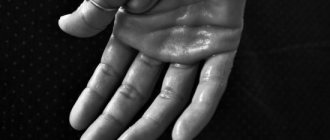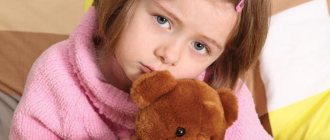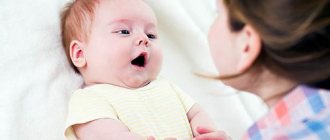08/12/2020 268 Infectology and neurology
Author: Elena
Bordetella pertussis is the causative agent of whooping cough. It affects the mucous membrane of the larynx, bronchi and lung tissue. This causes attacks of dry cough, which lead to hemorrhages in the mucous membranes. When coughing, you may notice the characteristic symptoms of whooping cough in children: bruises or hemorrhages that are visible on the face. Due to the fact that parents refuse routine vaccination, there has recently been an increase in the incidence of the disease.
[Hide]
Causes and risk factors
Whooping cough in children is caused by the gram-negative bacillus Bordetella pertussis, which is very unstable in the external environment. When exposed to disinfectants in normal concentrations, it dies almost instantly. Direct sunlight will destroy its viability after 60 minutes.
Source: medaboutme.ru
Whooping cough is a typical anthroponotic infection. Its source is sick people and bacteria carriers. Whooping cough in older children and adults usually occurs in an erased form, which poses a serious epidemiological danger. Patients are infectious to others from days 1 to 25 of the disease. With antibacterial therapy, the duration of the infectious period may be reduced.
The spread of infection occurs exclusively through airborne droplets during coughing (through an aerosol of infected sputum). Due to the extreme instability of the Bordetella pertussis bacillus in the environment, contact and household transmission of infection is not observed. Considering that the infected aerosol spreads over a short distance (no more than 2 meters), children become infected with whooping cough only when they are in fairly close contact with patients.
Susceptibility to whooping cough in children is high. After an illness, stable immunity is formed, usually lifelong. However, in old age, the tension of the immune system may weaken, which explains the sometimes observed cases of recurrent disease.
When infected, the pertussis bacillus enters the mucous membrane of the upper respiratory tract and affects the cells of the ciliated epithelium of the bronchi and larynx. The pathogen does not penetrate into deeper tissues and does not spread throughout the body. In the process of life, it produces toxins that cause the development of a local inflammatory reaction.
Severe whooping cough in children can be complicated by hemorrhages under the mucous membranes, into the tissues of internal organs and the brain, as well as the development of emphysema, pulmonary atelectasis, and pneumothorax.
After the death of pertussis sticks and the destruction of their shells, endotoxin is released, which provokes attacks of spasmodic cough. Subsequently, in children, a focus of excitation is formed in the medulla oblongata, and the cough acquires a central genesis. As a result, a coughing attack can be triggered by various irritants, for example, a long conversation, strong laughter, pain, touching. Excitation from the cough center can also spread to neighboring centers of the medulla oblongata. Therefore, after a cough attack, vascular spasm, increased blood pressure, and reflex vomiting are sometimes observed. During a severe coughing attack, children often experience clonic or tonic convulsions.
Endotoxins from pertussis bacillus and the enzyme adenylate cyclase produced by it help weaken the immune system, which, in turn, increases the risk of long-term bacterial carriage or secondary infection.
An adult with whooping cough
Is whooping cough contagious to adults? Yes, it is quite possible for an adult to become infected. If a person’s immunity is very weakened, then the likelihood of becoming infected with whooping cough bacteria increases. Vaccines that are given to adults are active for a fairly short time - about 6 years. Therefore, it is recommended to vaccinate not only children, but also adults.
Source: fb.ru
Symptoms of whooping cough in children
The incubation period for whooping cough in children lasts from 3 to 15 days. In the clinical picture of the disease there are several successive periods:
- catarrhal (prodromal);
- spasmodic (convulsive) cough;
- permissions.
The prodromal period lasts from 2 to 10 days. It is characterized by a runny nose with severe mucous rhinorrhea and a moderate dry cough. The general condition remains satisfactory, there are no signs of intoxication. The cough gradually increases, it takes on a paroxysmal character and intensifies at night.
The main symptom of whooping cough in children is a convulsive cough. Its appearance indicates the transition of the disease to the next stage. Coughing attacks become frequent and intense, becoming spastic in nature.
In children in the first years of life, whooping cough can cause the development of chronic lung diseases, including bronchiectasis.
Older children note symptoms that are warning signs of an impending attack:
- anxiety;
- chest discomfort;
- sore throat.
Spastic narrowing of the glottis causes the appearance of an extended whistling inhalation, the so-called reprise. In fact, the attack is an alternation of reprises and convulsive coughing exhalations. It ends with the discharge of glassy mucous viscous sputum or reflex vomiting.
Attacks most often occur at night and early in the morning. Due to significant tension on the conjunctiva, mucous membrane of the oropharynx and the skin of the face, small hemorrhages (petechiae) appear.
Body temperature remains within normal limits. If it increases, this is evidence of a secondary bacterial infection.
The period of convulsive cough lasts 3-4 weeks, after which whooping cough in children gradually enters the resolution phase. The attacks gradually lose their spasmodic nature, become shorter, the interval between them lengthens and after a while they completely stop. The duration of the permit period ranges from several days to several months. This is explained by the fact that even after the main symptoms subside, general asthenia and increased nervous excitability of the cough center persist for a long time.
In vaccinated individuals, the disease may occur in an erased form. In this case, a sign of whooping cough in children is a long-lasting cough that is practically untreatable. The spastic nature of the cough is weakly expressed. Vascular spasms, vomiting and relapses are absent.
During a medical examination at the source of infection, cases of subclinical whooping cough in children can be identified, the only symptom of which is an intermittent cough.
The use of antitussive drugs with a central mechanism of action is contraindicated. Mucolytics and expectorants are ineffective, so they are also not prescribed.
In the abortive form, whooping cough in children stops at the stage of catarrhal manifestations. There are no attacks of convulsive cough, regression of clinical signs occurs very quickly.
Diagnostics
Diagnosis of whooping cough in children is based on the characteristic clinical picture. Confirmation of the diagnosis is carried out by laboratory diagnostic methods based on the identification of pertussis bacillus or its antigens:
- inoculation of mucus from the throat on selective media (casein-charcoal agar or glycerin-potato agar with the addition of blood) - inoculation should be carried out in the first days of the disease before the start of antibacterial therapy;
- detection of pertussis bacillus antigens in throat mucus using the RIF method;
- detection of antibodies to the pertussis bacillus antigen (RSC and passive hemagglutination, ELISA);
- latex microagglutination reaction in child saliva samples.
With whooping cough in children, certain changes are also observed in the general blood test, which indicate an infectious process occurring in the body (lymphocytic leukocytosis, a slight increase in ESR).
An x-ray of the chest organs reveals increased transparency of the lung fields (a sign of emphysema), flattening of the dome of the diaphragm and increased pulmonary pattern with the appearance of reticularity.
Whooping cough in children requires differential diagnosis with other respiratory diseases (ARVI, bronchitis, tracheitis, pneumonia).
Re-infection
Such cases are the exception to the rule, but sometimes they still happen. Sick children are treated under the supervision of specialists who force their immunity to produce special antibodies that successfully destroy the whooping cough bacillus. Therefore, most children who get sick again cough for a completely different reason, not caused by the notorious bacterium. And if at this moment there are other children next to them, then the latter are relatively safe.
Over the course of several years, the immune system stops responding to this bacterium, so vaccinations must be done regularly. Without them, the body has a harder time tolerating all the symptoms associated with the disease. The vaccine also affects how long whooping cough is contagious.
If infection does occur, you should immediately consult a doctor. Age is no barrier for a wand. About 12% of patients are teenagers and older adults.
Treatment of whooping cough in children
Treatment of whooping cough in children is in most cases carried out on an outpatient basis. Hospitalization is indicated only in severe cases of the disease and the addition of a secondary infection.
The patient should be isolated in a separate room, which is wet cleaned and ventilated several times a day.
Cups and mustard plasters are contraindicated; their use can provoke a severe cough attack.
Children in the first year of life remain breastfed. At an older age, dietary table No. 13 according to Pevzner is prescribed. The goals of diet therapy are:
- increasing the body's resistance to infection;
- stimulation of defenses;
- reduction of intoxication;
- creating optimal conditions for the immune system.
The diet includes:
- dried white bread, savory cookies;
- weak fish and meat broths, vegetable and meat puree soups, slimy cereal soups;
- steam cutlets, meat soufflé, meatballs;
- steamed fish cutlets, fish aspic;
- fermented milk products (ryazhenka, acidophilus, kefir, cottage cheese, sour cream);
- cheese and feta cheese;
- protein steam omelet, soft-boiled eggs;
- semi-liquid viscous porridges;
- berries and fruits (soft, ripe and sweet);
- some types of sweets (honey, preserves, jam, meringue, mousses, jelly, marshmallows, marmalade);
- vegetable and butter;
- tea with lemon, rosehip infusion.
- compotes, fruit drinks, diluted fruit and vegetable juices;
Exclude from the diet:
- fresh rye and wheat bread, baked goods;
- strong and fatty broths;
- fatty meats and fish, sausages, smoked meats;
- legumes;
- canned food, pickles and marinades;
- sharp cheeses, cream, whole milk;
- hard-boiled eggs, scrambled eggs;
- porridges made from corn, pearl barley, egg and millet;
- vegetables with coarse fiber (mushrooms, rutabaga, white cabbage, radish, radishes, turnips);
- cakes and pastries;
- cocoa and chocolate.
In the catarrhal period, treatment of whooping cough in children is carried out with antibiotics (macrolides, aminoglycosides) in a weekly course in an average therapeutic dosage. In the first days of the disease, along with antibiotics, children can be prescribed a specific anti-pertussis gamma globulin.
Unlike most other droplet infections in children, whooping cough even affects newborns.
To suppress paroxysmal cough, it is recommended:
- long stay of the child in the fresh air (in calm weather and air temperature not lower than -10 ° C;
- prescription of sedatives and antihistamines.
For severe coughing attacks, antipsychotics may be prescribed.
The use of antitussive drugs with a central mechanism of action is contraindicated. Mucolytics and expectorants are ineffective, so they are also not prescribed. Cups and mustard plasters are contraindicated; their use can provoke a severe cough attack.
Source: extempore.info
During the period of convulsive cough, HBOT (hyperbaric oxygen therapy) has a good therapeutic effect. In addition, physical therapy, for example, inhalation of proteolytic enzymes, is widely used.
For severe whooping cough with apnea, theophylline and corticosteroids are prescribed for a short course. For prolonged apnea, chest massage and artificial ventilation are performed.










